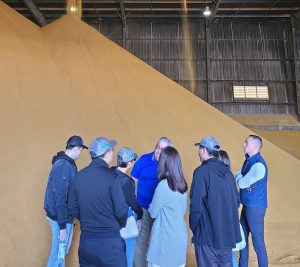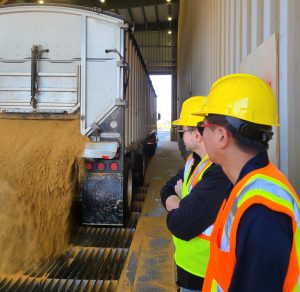After the conclusion of Export Exchange 2024, held earlier this month in Fort Worth, Texas, many international participants continued their mission by attending trade team post-tours to see the U.S. agricultural supply chain firsthand.
Trade teams are critical to the U.S. Grains Council’s (USGC’s) mission of developing markets, enabling trade and improving lives. Export Exchange offered eight pre-conference trade teams and 13 post-conference teams with participants from 43 countries and visiting 20 states.
One trade team, hosting delegates from influential grain buyers and traders from countries including Indonesia, Singapore and Vietnam, travelled to Illinois after the event. These delegates included some of the largest buyers of corn, distiller’s dried grains with solubles (DDGS) and soybeans in the region.
Although trade teams can be short, attendees are able to witness a significant segment of the U.S. value chain within a few packed days. Detailed below are the activities of this post-conference trade team in central Illinois and Chicago.

The tour began Thursday with a drive to Gibson City, Illinois, where attendees met with Steve Kelly, the CEO of One Earth Energy, a regional ethanol plant established in 2009. There, delegates discussed the DDGS production process at the plant, saw the freshly produced DDGS and watched the container loading and shipping procedure.
Illinois Corn Director of Exports and Logistics, Collin Watters, joined the delegates on the tour and hosted a lunch at the Illinois Corn headquarters Thursday.
“The Illinois Corn Marketing Board invests significant funding in the U.S. Grains Council because the Board knows just how critical exports are to the industry,” Watters said.
“The Southeast Asia feed grains team that visited Illinois was another example of the value that the Council and its state partners can bring to the industry. The group was very engaged, highly sophisticated and eager to learn more about the business opportunities here. I’m very optimistic that we will see sales generated as a direct result of this mission.”

After lunch, attendees visited USGC At-Large Director Jim Reed’s farm in De Land, Illinois, to watch soybean harvest and learn more about his family farm operation. Reed shared that this year’s corn crop is exceptionally good, rearing about 250 to 280 bushels per acre. Attendees examined the corn and soybean crops while watching the harvesting process in action.
The evening concluded with a networking event hosted by a USGC-member company that ships agriculture products around the globe. The event served as an opportunity for the delegates to discuss potential business opportunities and learn more about their shipping practices.

Friday began with a visit to an inland port in Joliet, Illinois, where delegates observed the process of how DDGS are transported from farm to port, a critical part of the U.S. value chain. Here, attendees watched how DDGS are inspected, dumped from the grain truck, loaded into shipping containers, placed onto railcars and shipped to the Mississippi River.
From there, the containers are placed on container ships and sent abroad. The transparency of this process is important for buyers to see exactly how products get processed and shipped to their countries in a manner ensuring safety and quality throughout.

To finish the tour, the Chicago Mercantile Exchange (CME), the largest agricultural products online derivatives marketplaces in the world, welcomed attendees to visit its global command center. Delegates met with the managing director global head of agricultural products and the director of agricultural products to discuss current and new features of the CME futures trading process.
These delegates use CME nearly daily in their positions, so the opportunity to connect with the people behind the database provided a chance to better understand the mechanisms of the CME trading process which could benefit their businesses in the future.
Trade teams offer the opportunity for attendees to visit each link in the value chain, inspect the quality of U.S. agricultural products, connect with farmers, shippers and traders while also building new business relationships. Delegates take this information and apply it to future business practices upon return to their countries. Trade teams strengthen ties between U.S. agriculture and the global market – building long-lasting relationships that help the Council achieve its mission of developing markets, enabling trade and improving lives.
About The U.S. Grains Council
The U.S. Grains Council develops export markets for U.S. barley, corn, sorghum and related products including distiller’s dried grains with solubles (DDGS) and ethanol. With full-time presence in 28 locations, the Council operates programs in more than 50 countries and the European Union. The Council believes exports are vital to global economic development and to U.S. agriculture’s profitability. Detailed information about the Council and its programs is online at www.grains.org.

